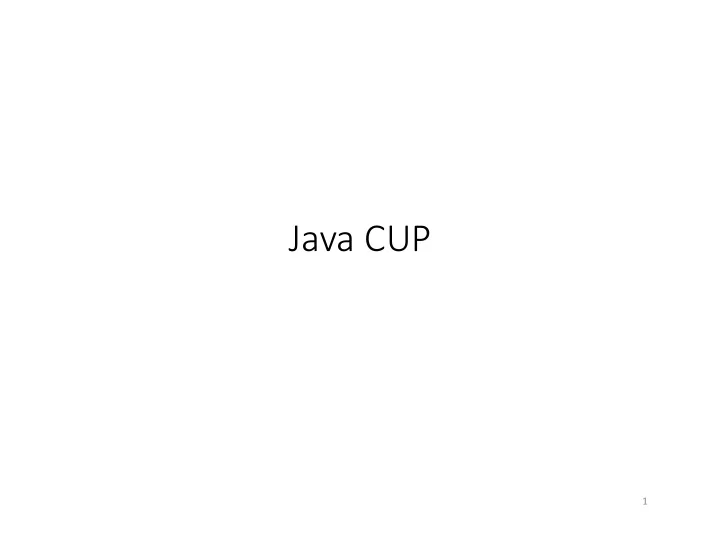

Java CUP 1
Last Time What do we want? – An AST When do we want it? – Now! 2
This Time A little review of ASTs The philosophy and use of a Parser Generator 3
Translating Lists CFG Input IdList -> id x, y, z | IdList comma id IdList AST IdNode IdNode IdNode IdList , id “z” “x” “y” “z” IdList , id “y” id “x” 4
Parser Generators Tools that take an SDT spec and build an AST – YACC: Yet Another Compiler Compiler – Java CUP: Constructor of Useful Parsers Conceptually similar to JLex Parser spec – Input: Language rules + actions (xxx.cup) – Output: Java code Java CUP Parser Source Symbols (parser.java) (sym.java) 5
Java CUP Parser.java – Constructor takes arg of type Scanner (i.e., yylex) – Contains a parsing method Parser spec • return: Symbol whose value contains (xxx.cup) translation of root nonterminal – Uses output of JLex Java CUP • Depends on scanner and TokenVals • sym.java defines the communication language Parser Source Symbols (parser.java) (sym.java) – Uses defs of AST classes • Also in xxx.cup Defines the token names used by both JLex and Java CUP 6
Java CUP Input Spec Grammar rules Expr ::= intliteral Terminal & nonterminal | id | Expr plus Expr declarations | Expr times Expr | lparens Expr rparens Optional precedence Terminal and Nonterminals terminal intliteral; and associativity terminal id; declarations terminal plus; lowest terminal minus; precedence terminal times; Grammar with rules first terminal lparen ; and actions [no actions terminal rparen ; non terminal Expr; shown here] Precedence and Associativity precedence left plus, minus; precedence left times; prededence nonassoc less; 7
Java CUP Example Assume ExpNode subclasses Step 1: Add types to terminals – PlusNode , TimesNode have terminal IntLitTokenVal intliteral; 2 children for operands terminal IdTokenVal id; terminal plus; – IdNode has a String field terminal times; – IntLitNode has an int field terminal lparen; Assume Token classes terminal rparen; – IntLitTokenVal with field non terminal ExpNode expr; intVal for the value of the integer literal – IdTokenVal with field idVal for the actual identifier 8
Java CUP Example Expr ::= intliteral {: :} | id {: :} | Expr plus Expr {: :} | Expr times Expr {: :} | lparen Expr rparen {: :} ; 9
Java CUP Example Expr ::= intliteral:i {: RESULT = new IntLitNode(i.intVal); :} | id {: :} | Expr plus Expr {: :} | Expr times Expr {: :} | lparen Expr rparen {: :} ; 10
Java CUP Example Expr ::= intliteral:i {: RESULT = new IntLitNode(i.intVal); :} | id:i {: RESULT = new IdNode(i.idVal); :} | Expr:e1 plus Expr:e2 {: RESULT = new PlusNode(e1,e2); :} | Expr:e1 times Expr:e2 {: RESULT = new TimesNode(e1,e2); :} | lparen Expr:e rparen {: RESULT = e; :} ; 11
Java CUP Example PlusNode Input: 2 + 3 left: right: Expr IntLitNode IntLitNode Expr plus Expr val: 2 val: 3 intliteral intliteral IntLitTokenVal IntLitTokenVal linenum: … linenum: … charnum: … charnum: … intVal: intVal: 2 3 Purple = Terminal Token (Built by Scanner) Blue = Symbol (Built by Parser) 12
Handling Lists in Java CUP stmtList ::= stmtList:sl stmt:s {: sl.addToEnd(s); RESULT = sl; :} | /* epsilon */ {: RESULT = new Sequence(); :} ; Another issue: left-recursion (as above) or right-recursion? • For top-down parsers, must use right-recursion • Left-recursion causes an infinite loop • With Java CUP, use left-recursion! • Java CUP is a bottom-up parser (LALR(1)) • Left-recursion allows a bottom-up parser to recognize a list s1, s2, s3, s4 with no extra stack space: recognize instance of “stmtList ::= epsilon” (current nonterminal stmtList) recognize instance of “stmtList ::= stmtList:current stmt:s1” [s1] recognize instance of “stmtList ::= stmtList:current stmt:s2” [s1, s2] recognize instance of “stmtList ::= stmtList:current stmt:s3” [s1, s2, s3] recognize instance of “stmtList ::= stmtList:current stmt:s4” [s1, s2, s3, s4] 13
UMINUS is a phony token never returned by Handling Unary Minus the scanner. UMINUS is solely for the purpose of being used in “%prec UMINUS” /* precedences and associativities of operators */ precedence left PLUS, MINUS; The precedence of a rule is that of the last precedence left TIMES, DIVIDE; token of the rule, unless assigned a specific precedence nonassoc UMINUS; // Also used for precedence of unary minus precedence via “%prec <TOKEN>” exp ::= . . . | MINUS exp:e {: RESULT = new UnaryMinusNode(e); :} %prec UMINUS /* artificially elevate the precedence to that of UMINUS */ | exp:e1 PLUS exp:e2 {: RESULT = new PlusNode(e1, e2); :} | exp:e1 MINUS exp:e2 {: RESULT = new MinusNode(e1, e2); . . . ; 14
Java CUP Demo 15
Recommend
More recommend